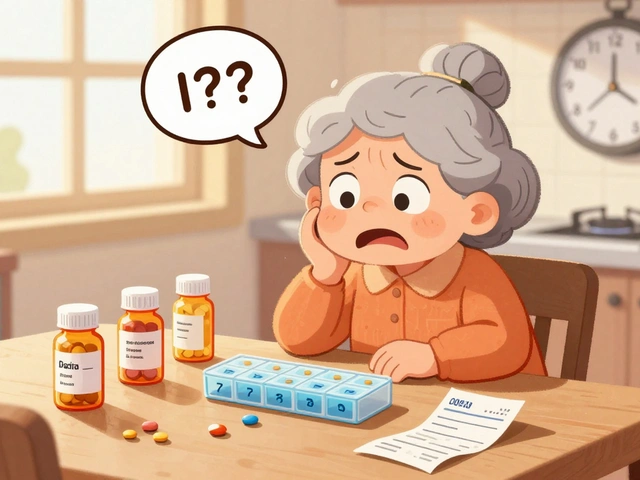Tamoxifen: How It Works, Benefits, Dosage & Side Effects Explained

TL;DR:
- Tamoxifen is a selective estrogen receptor modulator used mainly for hormone‑responsive breast cancer.
- It blocks estrogen in breast tissue but can act like estrogen in bone and uterus.
- Typical dose for cancer treatment is 20mg daily for 5‑10 years; lower doses (10‑20mg) are used for risk reduction.
- Common side effects: hot flashes, menstrual changes, mood swings, and rare but serious risks like blood clots and endometrial cancer.
- Regular monitoring-blood tests, pelvic exams, and bone density scans-helps catch problems early.
What Is Tamoxifen and How Does It Work?
Tamoxifen belongs to a class called selective estrogen receptor modulators (SERMs). In simple terms, it is a chemical that can both block and mimic estrogen depending on where it lands in the body. In breast cells that need estrogen to grow, Tamoxifen sticks to the estrogen receptors and says, "No thanks, I'm taken." This blocks the hormone’s growth‑promoting signal and can shrink or stop the spread of tumors that rely on estrogen.
Why does it act like estrogen in other places? The drug’s shape allows it to fit differently into the receptor’s pocket in bone, liver, and the uterus. In bone, it actually helps keep calcium in, acting as a protective agent against osteoporosis-a useful side effect for many post‑menopausal women on long‑term therapy.
Key points from the scientific literature (e.g., Early Breast Cancer Trialists' Collaborative Group, 2023) confirm that Tamoxifen reduces breast‑cancer recurrence by roughly 40% and reduces mortality by about 30% when taken for five years after surgery.
When and How Is Tamoxifen Used?
Doctors prescribe Tamoxifen for three main situations:
- Adjuvant therapy: after tumor removal to lower the chance of the cancer coming back.
- Neoadjuvant therapy: before surgery to shrink a tumor.
- Risk reduction: for women (and occasionally men) with a high genetic risk, such as a BRCA mutation.
Typical dosing schedules look like this:
| Indication | Typical Dose | Duration |
|---|---|---|
| Adjuvant (post‑surgery) | 20mg orally once daily | 5‑10years |
| Neoadjuvant (pre‑surgery) | 20mg orally once daily | 4‑6months |
| Risk reduction (high‑risk) | 10‑20mg orally once daily | 5‑10years |
Take the tablet with or without food, at the same time each day, to keep blood levels steady. If you miss a dose, take it as soon as you remember-unless it’s almost time for the next dose, then just skip the missed one. Doubling up can increase side‑effect risk without boosting benefit.
Special populations need adjustments:
- Pregnant or breastfeeding women: avoid Tamoxifen; it can harm a developing fetus.
- Patients with liver impairment: dose may be reduced; liver enzymes are monitored every 2‑3 months.
- Men with breast cancer: the same 20mg regimen applies, but watch for gynecomastia and testosterone changes.

Managing Side Effects and Monitoring
Side effects are the main reason people stop taking Tamoxifen, so proactive management matters.
Hot flashes-the most common complaint-can be eased with lifestyle tweaks: dress in layers, keep the bedroom cool, avoid caffeine and spicy foods. Some clinicians add low‑dose SSRIs (like venlafaxine) that don’t interfere with the drug’s anti‑cancer action.
Menstrual changes-irregular periods or missed cycles-are typical in pre‑menopausal women. If bleeding becomes heavy or prolonged, a pelvic exam is warranted to rule out endometrial hyperplasia.
Blood clots (deep‑vein thrombosis or pulmonary embolism) occur in about 1‑2% of users. Risk spikes with smoking, obesity, or a personal clot history. Counsel patients to stay active, maintain a healthy weight, and seek immediate help if they notice leg swelling or sudden breathlessness.
Endometrial cancer risk rises modestly after long‑term use. Regular gynecologic visits-typically an annual pelvic exam plus ultrasound if symptoms appear-help catch abnormal growth early.
Bone health is a bright spot: Tamoxifen can improve bone mineral density. However, a baseline DEXA scan and a follow‑up after 2‑3 years give a clear picture of any gains.
Routine monitoring schedule:
- Baseline blood work: liver function, CBC, lipid panel.
- Every 3‑6months: liver enzymes and cholesterol (Tamoxifen can raise triglycerides).
- Yearly: pelvic exam, endometrial thickness assessment if symptomatic.
- Every 2‑3years: DEXA scan for bone density.
If side effects become intolerable, doctors may consider switching to an aromatase inhibitor (for post‑menopausal women) or adjusting the dose. Never stop therapy abruptly without consulting a clinician; abrupt cessation can cause a rebound in estrogen activity.
Finally, a few practical tips to improve adherence:
- Set a daily alarm or use a pill‑tracking app.
- Keep a small medication box at bedside to pair with night‑time routines.
- Discuss any new symptom with the care team right away-most issues can be mitigated.
By staying informed, monitoring regularly, and working with a trusted healthcare team, patients can reap Tamoxifen’s life‑saving benefits while minimizing drawbacks.
Mini‑FAQ
- Can I take Tamoxifen with birth control? Yes, but hormonal contraceptives may be less effective; consider non‑hormonal methods.
- Is Tamoxifen safe for men? It’s approved for male breast cancer and works similarly; watch for libido changes.
- Will Tamoxifen cause weight gain? Direct weight gain isn’t typical, but some patients report increased appetite; a balanced diet helps.
- Do I need to avoid soy? Moderate soy intake isn’t a problem; extreme high‑soy diets could theoretically affect estrogen balance, but evidence is weak.
- What if I’m on a statin? No major interactions; however, both can affect liver enzymes, so monitor labs.

Next Steps & Troubleshooting
If you’re newly prescribed Tamoxifen, schedule your baseline labs within the next week and set a daily reminder. If you notice a new symptom-especially leg swelling, severe pelvic pain, or sudden vision changes-contact your oncologist immediately. For milder side effects, keep a symptom diary and bring it to your next appointment; small tweaks often solve the problem without changing the medication.
In case you’re considering stopping early because of side effects, discuss a gradual taper or alternative therapy with your doctor. Remember, the five‑year survival benefit drops sharply once therapy ends prematurely.
Lastly, join a support group-either in‑person at your hospital or online. Hearing how others manage the same challenges can provide practical ideas that aren’t listed in any pamphlet.
8 Comments
Chris Kivel
Thanks for the thorough rundown on Tamoxifen; it’s great to have a single place that covers the mechanism, dosing options, and practical tips for managing side effects.
sonia sodano
While the article is undeniably comprehensive, it glosses over the nuanced pharmacogenomics that can dictate a patient’s response, and that omission feels a bit careless for a piece purporting to be “explained”. Moreover, the blanket recommendation for “daily reminders” ignores cultural variations in medication adherence. A more critical lens would have highlighted where the data are still evolving.
Praveen Kumar BK
It’s worth noting that the original text contains several grammatical oversights-“a chemical that can both block and mimic estrogen depending on where it lands in the body” is clunky, and “the drug’s shape allows it to fit differently into the receptor’s pocket” could be tightened for clarity. Precision in language mirrors precision in prescribing; both deserve equal attention.
Viji Sulochana
i think the info about bone health is super helpful but the part about soy could b clearer its not a big deal but the article makes it sound like a huge risk lol
Stephen Nelson
Tamoxifen’s dualistic nature as both antagonist and agonist offers a fascinating case study in selective receptor modulation. In the breast, it outcompetes endogenous estrogen for the ligand‑binding domain, effectively starving the tumor of proliferative signals. Conversely, in bone tissue, the same molecular scaffold adopts a conformation that recruits co‑activators, thereby preserving mineral density. This paradox underscores the importance of tissue‑specific co‑factor expression, a principle that extends beyond oncology into endocrinology at large. Clinicians often celebrate the 40 % recurrence reduction as a triumph, yet the same data hide a modest increase in endometrial pathology that demands vigilance. The risk–benefit calculus becomes even more intricate when patients possess BRCA mutations, because the prophylactic advantage must be weighted against long‑term adverse events. Moreover, the pharmacokinetic variability introduced by hepatic enzyme polymorphisms can alter plasma concentrations, leading some individuals to experience heightened hot‑flashes while others notice hardly any side effects. From a philosophical standpoint, prescribing Tamoxifen forces us to confront the ethics of imposing a five‑year pharmacological regimen on otherwise healthy individuals. Is it justifiable to expose a patient to a 1‑2 % clot risk for a statistical survival gain, or does the principle of “do no harm” demand a more conservative approach? These questions are not merely academic; they shape consent conversations and influence adherence patterns. The article’s practical tips-such as setting alarms and keeping a medication box-are sound, yet they presuppose a level of health literacy that is not universally present. Health systems should therefore pair these reminders with culturally tailored education to bridge that gap. The recommendation to monitor liver enzymes every few months is prudent, but clinicians must also remain alert to drug‑drug interactions, especially with statins that share metabolic pathways. Finally, the suggestion to join support groups recognizes the psychosocial dimension of long‑term therapy, offering patients a communal coping mechanism that can mitigate the emotional toll. In sum, Tamoxifen remains a cornerstone of hormone‑responsive breast cancer management, but its successful deployment hinges on nuanced, individualized care that balances mechanistic insight with patient‑centered pragmatism.
Fredric Chia
The monitoring schedule is appropriate; however, consideration of patient burden could refine the frequency of imaging studies.
Hope Reader
Great, another life‑saving drug that comes with a side‑effect checklist-just what my weekend needed 😊.
Marry coral
Stop sugarcoating it, Tamoxifen isn’t a miracle pill; it’s a heavy‑duty hormone blocker with real downsides.






Write a comment